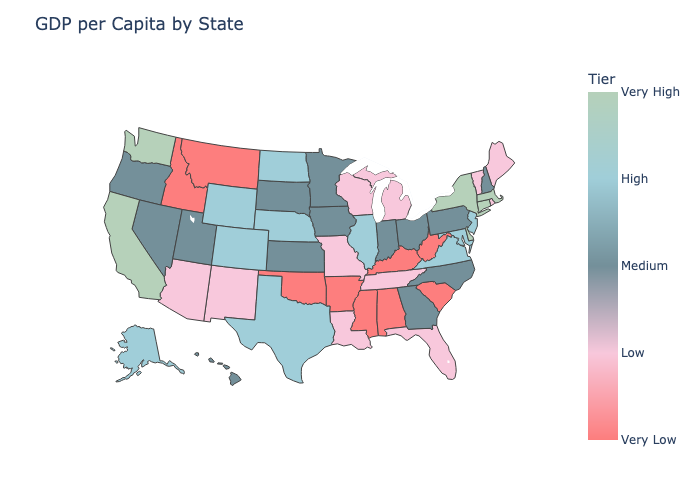Last time
Regional
This breakout looks superficially attractive but still masks a lot of variability.
State level
If we divide the states into three categories of gross domestic product based on where they fell in the league table, there are four top states that make up 40% of the national GDP, another 16 to get to 80% and then the rest.
And I noted that was also unsatisfactory because, in fact, many things are proportional to population, which is why the big states are also the ones with the most traffic accidents, or police-involved shootings or whatever. We need to take that into account by adjusting for population
Per capita
This provides a more granular view than simply categorizing the states by the relative dollar amount of their GDPs because it shows the combined effect of population and economic activity.
Low per capita states
The states in red have economies that the have the lowest production of goods and services per capita. They may also appear near the bottom of many other types of state rankings. To take an example from education, here are rankings for Fall 2023 expenditures per student enrolled in K-12:
Idaho 51
Oklahoma 49
Mississippi 44
Arkansas 43
Alabama 41
South Carolina 34
Kentucky 33
Montana 32
West Virginia 26
It’s intuitively appealing to think that states with lower GDP per capita have less to spend on public services, but that’s not the whole story of course, because while Idaho, which is 51st in school expenditures per study and it is 46th in per capita GDP, West Virginia which is 50th in GDP per capital is 26th in educational spending, right in the middle. To avoid economic determinism in redrawing boundaries we should keep in mind that there are always other factors.
High per capita states
The Left Coast states of California and Washington and the Acela Corridor states from Boston to Washington DC have correspondingly high educational expenditures per capita ranks
New York 1
Washington DC 2 (DC is in a class of its own for GDP per capita)
Connecticut 5
Massachusetts 6
Rhode Island 10 (RI, however is low GDP per capita)
Washington 15
Maryland 16
California 17
Delaware 18
The same caution regarding economics not being the totality apply here, too.
Studio exercise—nation building using GDP.
As a simple case of how GDP might serve as a departure point for nation building, let’s create Concordia, consisting of New England.
This is a nice place to start because:
It has a mix of GDP tiers, as defined by the national scale
There are only two borders—NY and Canada—and the other boundary is maritime.
There’s a long regional history
It has a mix of metropolitan, suburban, rural and back-of-beyond land use patterns
Its only cross border entanglement is between southwest Connecticut and New York
Even so, the reality is more concentrated
This is composite NASA imagery of New England at night, with a view from the Gaspe Peninsula at the top, in Canada, the Greater Boston area toward the bottom and the Connecticut Valley corridor from New Haven north to Hartford and Springfield. The large urban area to the west is Quebec City.
The numbers
We can see from this, as suggested by the lighting, that economic activity is higher in Massachusetts and Connecticut and it is more intense in terms of output per capita. So, within this nation, who meeds whom and what might the hinterlands ask for in exchange for a voting disadvantage? And, if population and economics translate into advantage, how should inequality be measured?
By the way. our fictional Concordia would rank about 75th in world population, admittedly way down there. But consider, although it falls Zimbawe by population, it is ahead of many developed countries, such as Sweden, Switzerland, Finland, Denmark, Norway and Ireland, just to name a few familiar countries.
And here’s a shocker, it would have approximately the same GDP as Saudi Arabia.
Next up
Continuing with Concordia, is the economy well balanced? Is it subject to decline to factors such as resource extraction exhaustion, climate change, brain drain, etc.? Does it have geopolitical challenges, including with Canada and the adjacent US-derived nation state?










